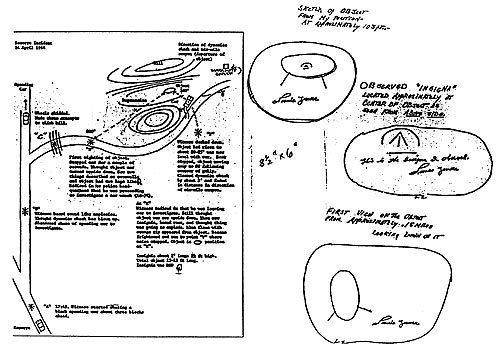
Map of Socorro landing site and Zamora's sketches of the object and its insignia, from the Project Blue Book case file. Courtesy of Brad Steiger.
THE UFO BRIEFING DOCUMENT
CASE HISTORIES
Last Page | Next Page
1964: LANDING CASE AT SOCORRO, NEW MEXICO
Until the experience of a small-town policeman in New Mexico, reports from persons claiming to have seen small beings in connection with UFOs on the ground (CE-III or Close Encounters of the Third Kind) were looked upon with considerable disfavor within the UFO research community. After the landing near Socorro, New Mexico, confirmed by a second reputable witness, attitudes changed. The years following this event produced an unprecedented flow of reports of high credibility and strangeness.
At about 5:45 p.m. on Friday, April 24, 1964 Socorro policeman Lonnie Zamora was chasing a speeding car when his attention was drawn to a peculiar sight in the sky. "At this time I heard a roar and saw a flame in the sky to the southwest some distance away." Thinking it might be an explosion connected with a building known to contain explosives, he forgot about the car chase, and sped off in the direction of the UFO.
The next time he saw it, it was on the ground, and from a distance it looked like a car that had overturned. As he drove closer, he could see that it resembled a large egg, sitting on one end and supported by slender legs. He stated:
"I saw two people in white coveralls very close to the object. One of these persons seemed to turn and look straight at my car and seemed startled -seemed to quickly jump somewhat. I don't recall noting any particular shape or possibly any hats or headgear. These persons appeared normal in shape -but possibly they were small adults or small kids."
As he drove closer, a small hill blocked his view of the object, though at one point he heard a noise like a door closing. When he could again see the object, there was no one near it. He drove as close as the rough terrain would permit, stopped, parked his police cruiser and got out, intending to walk toward the craft. At this point "I heard about two or three loud 'thumps,' like someone possibly hammering or shutting a door or doors hard. These 'thumps' were possibly a second or less apart."
The white-suited individuals were not seen after he heard the thumps. As he started towards the object, it began to roar:
"It started at a low frequency, but quickly the roar rose in frequency and in loudness... Flames were under the object... light blue and at bottom was a sort of orange color."
Assuming it might be about to explode, Zamora quickly hid behind his cruiser for protection. The roaring then stopped and he looked up to see it hovering a few feet above the ground. "It was so quiet you could have heard a pin drop." The vehicle then moved away slowly, gathering speed as it headed toward the dynamite shack, which it cleared by a few feet.
|
|
At this time, Zamora was joined by a police sergeant who watched the craft fly away into the distance. Zamora and the sergeant then walked to where it had been parked, and noted charred and singed grass, underbrush and imprints in the ground corresponding to where the vehicle had landed.62
Within hours, Zamora was interviewed by U.S. Army Captain Richard T. Holder, Up-Range Commander of the White Sands Missile Range, and by FBI Special Agent Arthur Byrnes, Jr., the latter requesting that the FBI's involvement be kept secret. Zamora described the object to them:
"It was smooth - no windows or doors. As the roar started, it was still on or near the ground. There was red lettering of some type. The insignia was about 2.5 feet [75 cm.] high and about 2 feet [60 cm.] wide. It was in the middle of the object. The object was... aluminum-white."
He then drew a sketch of the object with the red "insignia": half of a circle over an inverted V with a vertical line inside and horizontal line below.63 (See map above.)
A day or two later, Dr. J. Allen Hynek arrived to investigate the report for the Air Force's Project Blue Book. In addition to questioning Zamora, Hynek measured and photographed the landing site. He located what appeared to be impressions in the ground made by the landing gear, as well as several small footprints.
The case received rapid and extensive press coverage, and the Air Force was under pressure to explain it as something less momentous than a landed spacecraft. Among the explanations considered and rejected were a rancher's helicopter and an experimental NASA lunar lander.
In the end, Project Blue Book declared the report "unsolved," and Major Hector Quintanilla, the project's final director, stated that there is no doubt that Lonnie Zamora saw an object which left quite an impression on him:
"There is also no question about Zamora's reliability. He is a serious police officer, a pillar of his church, and a man well versed in recognizing airborne vehicles in his area. He is puzzled by what he saw, and frankly, so are we. This is the best-documented case on record, and still we have been unable, in spite of thorough investigation, to find the vehicle or other stimulus that scared Zamora to the point of panic."64
_______________________________________
FOOTNOTES
62. Written statement by Lonnie Zamora to Project Blue Book, 1964; reprinted in Steiger, Brad, ed. Project Blue Book, ibid.
63. Ibid.
64. Quintanilla, Hector, "The Investigation of UFO's," Studies in Intelligence, Vol. 10, No. 4, Fall 1966.